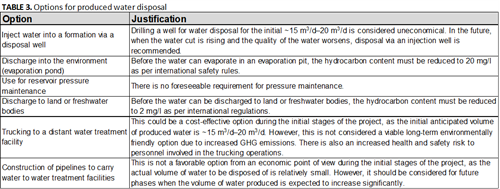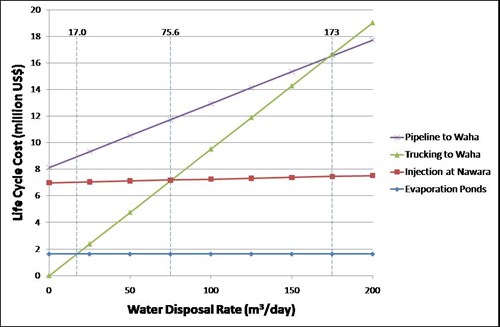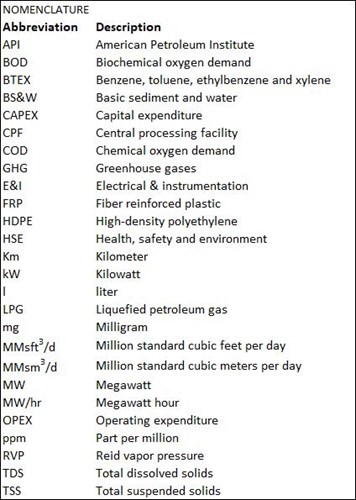A comparison study of water disposal methods in a gas project—Part 2
Produced water refers to water associated with the production of oil and/or natural gas from a well. Produced water may also include water produced from a reservoir or water injected into the wellbore to increase the formation pressure for improved hydrocarbon recovery.1,2 The concentration of constituents and the volume of produced water differ dramatically depending on the type and location of the petroleum product.3–5 Generally, the ratio of oil and produced water is 1:3 for most oil wells.6
Produced water quality varies significantly based on geographical location, type of hydrocarbon produced and the geochemistry of the producing formation. In general, the total dissolved solids concentration can range from 100 mg/l to > 400,000 mg/l. Silt and particulates, sodium, bicarbonate and chloride are the most commonly occurring inorganic constituents in produced water. Benzene, toluene, ethylbenzene and xylene (BTEX) compounds are the most commonly occurring organic contaminants in produced water.7–9 The types of contaminants found in produced water and their concentrations have a large impact on the most appropriate type of beneficial use and the degree and cost of the treatment required.10,11
Many different technologies can be used to treat produced water; however, the types of constituents removed by each technology and the degree of removal must be considered to identify potential treatment technologies for a given application.12–16 For some types of produced water, more than one type of treatment technology may be capable of meeting the contaminant removal target, and a set of selection criteria must be applied to narrow down multiple treatment options.17,18
Large water volumes also can cause environmental impacts through erosion, large land area disposal basins, and pipeline and road infrastructure.19 Water-hauling spills and unplanned discharges are all risks when managing produced water.20 The volume of the receiving body is critical in determining environmental impacts: ocean discharge offers substantive dilution, while small streams offer low dilution capacity.21–23 Globally, +/- 250 MMbbl of water are produced daily from both oil and gas fields, and more than 40% are discharged into the environment.24
The most popular option to handle produced water is to reinject it back into the formation. Produced water reinjection requires minimal or modified treatment before injection to obtain better results, but the injectivity decreases with time. As the reservoir matures, injected produced water swipes through to the producing zone and water production increases with time, which causes abandonment of the well. Transportation of produced water from production to injection sites increases reinjection costs.25–28
The main objectives of this study are: to compare water injection into a formation via a disposal well to maintain reservoir pressure of wells, water discharge into the environment (evaporation ponds), trucking water from the gas project to the neighbor facilities, and installing 4-in. pipeline from the gas project to the neighbor facilities for produced water disposal of the gas project; to select the best method based on technical factors, capital and operating expenditures; and to comply with environmental regulations.
Part 1 of this article appeared in the January issue of Gas Processing & LNG
Produced water disposal options in the gas project. TABLE 3 shows options for produced water disposal in the gas project and the justifications for each method.
 |
CAPEX COMPARISON
Evaporation ponds. The CAPEX cost estimate includes a cost for the excavation and lining of an evaporation pond. This CAPEX is based on two evaporation ponds of sufficient volume for 228 m3/d each (131 m x 131 m x 1.5 m), which is more than the water disposal range examined by this technical note. Evaporation ponds CAPEX = ~$1,8 MM.
The excavation is required to provide the limestone for construction. The additional cost to utilize the excavated pit as an evaporation pond is an allowance for leveling, the supply and installation of the geo-textile membrane, and an access road. The CAPEX for a suitable oil skimming device for removing any free hydrocarbons on the surface is ~$67,000.
Injection well at the gas project CPF. The cost of drilling a water disposal well at the gas project CPF is assumed to be $7 MM. Other required costs are shown in TABLE 4.
 |
Trucking water to neighbor facilities. The additional CAPEX investment required to cater for trucking water to the neighbor facilities is assumed negligible.
Pipeline to neighbor facilities. The cost for the pipeline option is estimated in TABLE 5.
 |
FIG. 5 summarizes the CAPEX comparison between all produced water disposal methods to eliminate the produced water.
 |
|
FIG. 5. CAPEX comparison of produced water disposal methods. |
From FIG. 5, installing pipeline from the gas project to neighbor facilities is the highest OPEX option.
OPEX comparison. An OPEX comparison was made based on the design capacity of the produced water disposal design capacity of 240 m3/d.
Evaporation ponds. The OPEX for evaporation ponds is assumed to be negligible when considered over the project’s lifetime. Occasionally, it will be necessary to clean the pond of any residue that may contain nonvolatile contaminants (including water soluble mercuric salts and elemental mercury) that have accumulated over an extended period of operation. This will be required for all options that make use of evaporation ponds at the gas project CPF as the main produced water disposal route.
Injection well at the gas project CPF. Well workover costs are $45,000/yr. This is a fixed cost regardless of water disposal volume. Electricity costs are $127 per MW/hr; this translates to $0.70/m3 for pumping (costs based on present Algeria prices).
Trucking water to the neighbor facilities. The cost of trucking water from the gas project CPF to neighbor facilities has been estimated at $2/bbl ($12.50/m3). Additionally, it is assumed that a further charge of $2/bbl ($12.50/m3) will be levied by the neighbor facilities to inject water from the gas project CPF.
Pipeline to the neighbor facilities. Electricity costs are $127 per MW/hr; this translates to $0.14 per m3 for pumping (costs based on present Algeria prices). Like trucking, a charge of $2/bbl ($12.50/m3) will be levied by the neighbor facilities to inject water from the gas project CPF. FIG. 6 reveals the daily OPEX comparison of the produced water disposal methods in the gas project based on the design capacity of the produced water equipment (240 m3/d).
FIG. 6 demonstrates that trucking water from the gas project to the neighbor facilities offers the highest OPEX per day compared to the other options.
 |
| FIG. 6. OPEX comparison of produced water disposal methods. |
Lifecycle cost comparison. TABLE 6 summarizes the CAPEX and OPEX for the produced water disposal options in the gas project and explains the fixed and variable OPEX for each option.
 |
FIG. 7 illustrates the lifecycle costs calculated based on the assumptions outlined above. The costs should be considered for comparative purposes rather than as an estimate of the absolute cost involved in the disposal of produced water from the gas project CPF. The values assume 3% inflation and a 10% discount/yr.
 |
| FIG. 7. Lifecycle costs for water disposal options for 25 yr. |
At very low water disposal rates—up to 17 m3/d—trucking is the most economical option (i.e., lowest lifecycle cost). At higher water disposal rates—> 17 m3/d—an evaporation pond is the most economical option. Injection of water at the gas project CPF is more economical than trucking at water disposal rates of > 76 m3/d. Using a pipeline to transport water to the neighbor facilities is the least economical option at water disposal rates of < 173 m3/d. A pipeline would be more economical than trucking water to the neighbor facilities at higher water disposal rates of > 173 m3/d.
Assuming a 10% water cut, the produced water treatment unit and evaporation ponds are presently designed to handle up to 168 m3/d. When only saturated hydrocarbon fluids (assuming no free water) flow to the CPF, the water cut is as low as 1.6% (26.9 m3/d; rich summer case). Therefore, it would be more economical to have an evaporation pond for the startup of the CPF than to use trucks to dispose of the initial produced water.
Takeaways. From the technical and CAPEX and OPEX comparisons of methods—water injection into a formation via a disposal well to maintain the reservoir pressure of the wells, water discharge into the environment (evaporation ponds), trucking water from the gas project to the neighbor facilities, and installing 4-in. pipeline from the gas project to the neighbor facilities—the following conclusions can be made:
- Water volumes for disposal are unlikely to be sufficiently high for long periods to require a pipeline to the existing neighbor facilities, irrespective of the HSE benefits, as any gas well experiencing water breakthrough will be identified and shut down for workover.
- Drilling of a dedicated disposal well at the gas project CPF will be excluded as an option. A depleted well may be used for water disposal subject to the flowline design conditions and metallurgy being suitable to transport the produced water to the wellsite at an adequate pressure.
- The evaporation pond is the best option for produced water disposal. A hard stand alongside the evaporation ponds for tanker access will be provided for occasional loading of residual water in the ponds to trucks for transport to the neighbor facilities.
Based on the technical and CAPEX and OPEX comparisons of the available methods for the produced water disposal in the gas project, it is highly recommended to use evaporation ponds for the produced water disposal in the gas project. GP
 |
LITERATURE CITED
- Kidnay, A. J., W. R. Parrish and D. G. McCartney, Fundamentals of natural gas processing, 3rd Ed., CRC Press, Boca Raton, New York, 2019.
- Noaman, A. A., “Modelling and optimization of the gas and condensate process facilities in the gas plant,” Australian Journal of Basic and Applied Sciences, Vol. 14, No. 12, 2020.
- Gas Processors Suppliers Association, GPSA Engineering Data Book, 14th Ed., Tulsa, Oklahoma, 2017.
- Ferro, B. D. and M. Smith, “Global onshore and offshore water production,” Oil & Gas Review OTC Edition, 2016.
- Bagheri, M., R. Roshandel and J. Shayegan, “Optimal selection of an integrated produced water treatment system in the upstream of oil industry,” Process Safety and Environmental Protection, Vol. 117, 2018.
- Simões, A., R. Macêdo, B. Santos, L. Silva, D. Silva and D. Ruzene, “Produced water: An overview of treatment technologies,” International Journal for Innovation Education and Research, Vol. 8, No. 4, 2020.
- AlAnezi, K., M. Al-Samhan, M. Belkharchouche, W. Abuhaimed, S. Alali, K. Alenizi and A. Alfuraij, “Comparative analysis of produced water collected from different oil gathering centers in Kuwait,” Journal of Environmental Protection, Vol. 9, 2018.
- Taghavinejad, A., S. Shafeie and A. Shirbazo, “Analysis of wastewater disposal in depleted tight gas reservoirs: A sustainable resources approach,” Journal of Construction Materials, Special Issue, 2021.
- U.S. Environmental Protection Agency (EPA), “Oil and gas extraction effluent guidelines,” Washington DC, 2019.
- Al-Ghouti, M. A., M. A. Al-Kaabi, M. Y. Ashfaq and D. A. Da´na, “Produced water characteristics, treatment and reuse: A review,” Journal of Water Process Engineering, Vol. 28, 2019.
- Menefee, A. H. and B. R. Ellis, “Wastewater management strategies for sustained shale gas production, Environmental Research Letters, IOP Publishing Ltd., January 2020.
- Xinchao, W., Z. Shicheng, H. Yuexin and A. Frederick, “Treatment of petrochemical wastewater and produced water from oil and gas,” Water Environment Research, Vol. 91, No. 10, 2019.
- Ebrahiem, E. E., A. A. Noaman, M. I. Mansour and M. S. Almutairi, “Produced water treatment design methods in the gas plant: Optimization and controlling,” Egyptian Journal of Chemistry, Vol. 64, No. 7, 2021.
- Fulazzaky, M., T. Setiadi and M. A. Fulazzaky, “An evaluation of the oilfield-produced water treatment by the membrane bioreactor,” Journal of Environmental Chemical Engineering, Vol. 8, Iss. 5, 2020.
- Bagheri, M., R. Roshandel and J. Shayegan, “Optimal selection of an integrated produced water treatment system in the upstream of oil industry,” Process Safety and Environmental Protection, Vol. 117, July 2018.
- Ersahin, M. E., H. Ozgun, R. Kaya, B. K. Mutlu, C. Kinaci and I. Koyuncu, “Treatment of produced water originated from oil and gas production wells: A pilot study and cost analysis,” Environmental Science and Pollution Research, Vol. 25, No. 7, 2018.
- Olajire, A. A., “Recent advances on the treatment technology of oil and gas produced water for sustainable energy industry-mechanistic aspects and process chemistry perspectives, Chemical Engineering Journal Advances, Vol. 4, December 2020.
- Manilal, A. M., P. A. Soloman and C. A. Basha, “Removal of oil and grease from produced water using electrocoagulation,” Journal of Hazardous, Toxic, and Radioactive Waste, Vol. 24, No. 1, 2020.
- Gazali, A. K., A. N. Alkali, Y. Mohammed, Y. Djauro, D. D. Muhammed and M. kodomi, “Environmental impact of produced water and drilling waste discharges from the Niger Delta petroleum industry,” IOSR Journal of Engineering, Vol. 07, No. 6, June 2017.
- Varjani, S., R. Joshi, V. K. Srivastava, H. H. Ngo and W. Guo, “Treatment of wastewater from petroleum industry: Current practices and perspectives, Environmental Science and Pollution Research, Vol. 22, 2020.
- Rasheed, T., M. Bilal, F. Nabeel, M. Adeel and H. M. Iqbal, “Environmentally-related contaminants of high concern: Potential sources and analytical modalities for detection, quantification, and treatment,” Environmental International, Vol. 122, 2019.
- Echchelh, A., T. Hess and R. Sakrabani, “Agro-environmental sustainability and financial cost of reusing gas field-produced water for agricultural irrigation,” Agricultural Water Management, Vol. 227, 2020.
- Hedar, Y. and Budiyono, “Pollution impact and alternative treatment for produced water,” E3S Web of Conferences, The 2nd International Conference on Energy, Environmental and Information System, Vol. 31, February 2018.
- Wei, X., S. Zhang, Y. Han and F. A. Wolfe, “Treatment of petrochemical wastewater and produced water from oil and gas,” Water Environment Research, Vol. 91, 2019.
- Al-Taq, A. A., M. N. Al-Dahlan and A. A. Alrustum, “Maintaining injectivity of disposal wells: From water quality to formation permeability,” SPE Middle East Oil & Gas Show and Conference, Manama, Kingdom of Bahrain, March 2017.
- Sahu, P., “A comprehensive review of saline effluent disposal and treatment: Conventional practices, emerging technologies, and future potential,” Journal of Water Reuse and Desalination, Vol. 11, No. 1, 2021.
- U.S. Environmental Protection Agency (EPA), “General information about injection wells,” Washington DC, 2016.
- Hasan, M., M. M. Rahman and M. Ahmed, “A short review of produced water management system for beneficial use,” American Journal of Agricultural Science, Engineering and Technology, Vol. 5, Iss. 1, 2021.
- Ahmed, Q. A., H. B. Nimir, M. A. Hussien, M. M. Zomrawi, E. M. Babiker and I. Fadul, “Evaluation of seepage from evaporation ponds of produced water in some Sudanese oilfields,” 2nd Conference of Civil Engineering, Sudan, 2018.
- Bangash, A., M. Ghayur and N. Khattak, “Evaluation and analysis of forced evaporation system for oil & gas production facilities in Pakistan,” International Journal of Innovative Science, Engineering & Technology, Vol. 2, No. 12, 2015.
- McLaughlin, M. C., T. Borch, B. McDevitt, N. R. Warner and J. Blotevogel, “Water quality assessment downstream of oil and gas produced water discharges intended for beneficial reuse in arid regions,” Science of The Total Environment, Vol. 713, 2020.
- Gray, M., “Reuse of produced water in the oil and gas industry,” SPE International Conference and Exhibition on Health, Safety, Environment, and Sustainability, Virtual, July 2020.
- Ilyas, M., F. M. Kassa and M. R. Darun, “A proposed framework of life cycle cost analysis for petrochemical wastewater treatment plants,” International Conference on Civil, Offshore and Environmental Engineering, Springer, Singapore, 2021.
- Mohammed, T. J. and J. M. Jasim, “Treatment of wastewater associated with crude oil in reservoirs,” Journal of Petroleum Research and Studies, Vol. 6, 2019.
- Siagian, U. W. R., S. Widodo, Khoiruddin, A. K. Wardani and I. G. Wenten, “Oilfield produced water reuse and reinjection with membrane,” MATEC Web of Conferences Vol. 156, 2018.
- Feder, J., “Saltwater disposal optimization drives water midstream sector,” Journal of Petroleum Technology, Vol. 72, No. 11, 2020.
- Al Qallaf, Y., S. Al-Kandari, K. Yousef, S. Al Mutairi and H. Fouzy, “Analysis and improvement possibilities of waste management at Kuwait Oil Company (KOC),” WIT Transactions on Ecology and the Environment, Vol. 202, 2016.
- Helaly, R., A. Bekheit, M. Farahaty and M. Tawfik, “Overcoming the typical operational problems & cost of water injection using dumpflooding,” North Africa Technical Conference & Exhibition, Cairo, Egypt, 2013.
- Kassab, M. A., A. E. Abbas, I. Elgamal, B. M. Shawky, M. F. Mubarak and R. Hosny, “Review on the estimating the effective way for managing the produced water: Case study,” Open Journal of Modern Hydrology, Vol. 11, 2021.
Abdelaziz Noaman is on the Faculty of Engineering within the Chemical Engineering Department at Minia University. He earned a PhD in chemical engineering from Minia University, Egypt in 2018 in the field of process and flow assurance engineering. Dr. Noaman is interested in the environment, water and wastewater treatment, corrosion, operations in oil and gas facilities, and pipeline networks. He has an extensive experience in using various process software, such as HYSYS, PIPESIM, OLGA, Flaresim, Gap and Pipe phase, and is keen on simulation of all oil and gas facilities and pipeline networks. Dr. Noaman is a Charter Engineer from the UK Engineering Council, a Consultant Engineer from the Egyptian syndicate of engineers, a European Engineer by the European Federation of National Associations and an International Professional Engineer by the UK Engineering Council. The author can be reached at abdelaziz.noaman@outlook.com.




Comments